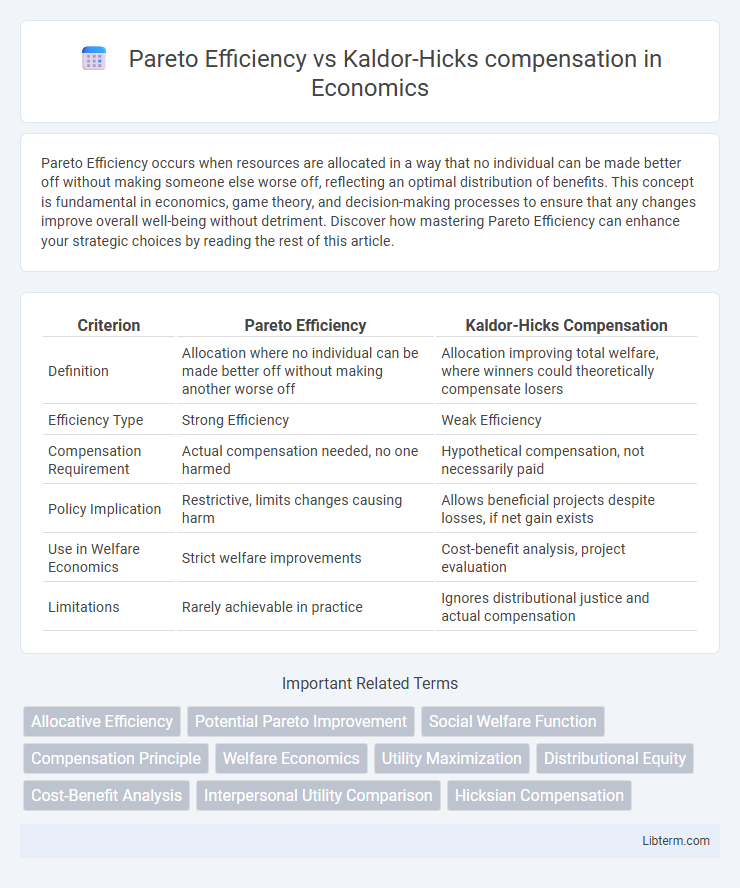Pareto Efficiency occurs when resources are allocated in a way that no individual can be made better off without making someone else worse off, reflecting an optimal distribution of benefits. This concept is fundamental in economics, game theory, and decision-making processes to ensure that any changes improve overall well-being without detriment. Discover how mastering Pareto Efficiency can enhance your strategic choices by reading the rest of this article.
Table of Comparison
| Criterion | Pareto Efficiency | Kaldor-Hicks Compensation |
|---|---|---|
| Definition | Allocation where no individual can be made better off without making another worse off | Allocation improving total welfare, where winners could theoretically compensate losers |
| Efficiency Type | Strong Efficiency | Weak Efficiency |
| Compensation Requirement | Actual compensation needed, no one harmed | Hypothetical compensation, not necessarily paid |
| Policy Implication | Restrictive, limits changes causing harm | Allows beneficial projects despite losses, if net gain exists |
| Use in Welfare Economics | Strict welfare improvements | Cost-benefit analysis, project evaluation |
| Limitations | Rarely achievable in practice | Ignores distributional justice and actual compensation |
Introduction to Economic Efficiency Concepts
Pareto Efficiency occurs when no individual can be made better off without making someone else worse off, representing an optimal allocation of resources in economics. Kaldor-Hicks compensation differs by suggesting an outcome is efficient if those who benefit could theoretically compensate those who lose, even if compensation does not actually take place. These foundational concepts guide welfare economics by evaluating resource distribution and potential improvements in social welfare.
Defining Pareto Efficiency
Pareto Efficiency defines an allocation where no individual's situation can be improved without worsening another's, representing an optimal distribution of resources. It requires that all potential mutual gains are exhausted, ensuring no further voluntary trades would benefit any party. This concept forms a benchmark in welfare economics for evaluating resource allocation efficiency without compensation mechanisms.
Understanding Kaldor-Hicks Compensation
Kaldor-Hicks compensation assesses economic efficiency by comparing potential gains against losses, allowing outcomes where winners could theoretically compensate losers, even without actual compensation occurring. Unlike Pareto Efficiency, which requires no individual to be worse off, Kaldor-Hicks permits changes benefiting overall welfare despite some parties experiencing harm. This criterion underpins cost-benefit analysis in policy decisions, highlighting its practical application in evaluating trade-offs and maximizing societal net benefits.
Key Differences Between Pareto and Kaldor-Hicks
Pareto Efficiency ensures no individual can be made better off without making someone else worse off, emphasizing actual consent and unanimous improvement. Kaldor-Hicks compensation allows for potential compensation where winners' gains exceed losers' losses, focusing on overall social welfare rather than unanimous agreement. The key difference lies in Pareto requiring feasible improvements benefiting all parties, while Kaldor-Hicks permits scenarios where those harmed could be compensated, even if compensation does not occur in practice.
Criteria for Evaluating Economic Outcomes
Pareto Efficiency evaluates economic outcomes by ensuring that no individual can be made better off without making someone else worse off, emphasizing allocative efficiency without compensation. Kaldor-Hicks compensation criteria allow for potential winners to hypothetically compensate losers, focusing on aggregate net benefits even if some individuals incur losses. These criteria guide policymakers in assessing trade-offs between efficiency and equity when evaluating projects or policy interventions.
Real-World Applications of Pareto Efficiency
Pareto Efficiency is widely applied in resource allocation and welfare economics to evaluate scenarios where no individual can be better off without making someone else worse off, ensuring optimal distribution of resources. Real-world applications include market equilibrium analysis, public policy design, and environmental regulation, where maintaining Pareto improvements helps in minimizing social costs and conflicts. Its strict criteria often contrast with Kaldor-Hicks compensation, which allows for potential compensation to losers, making Pareto Efficiency more relevant for fair and stable economic outcomes.
Practical Uses of Kaldor-Hicks Compensation Principle
Kaldor-Hicks compensation principle is widely applied in cost-benefit analysis to evaluate public projects where total gains exceed total losses, even if not all losers are fully compensated. This principle facilitates practical decision-making by allowing policy changes that improve overall economic efficiency, provided potential compensation for those disadvantaged is theoretically possible. It underpins infrastructure development, environmental regulation, and urban planning where trade-offs between winners and losers require non-ideal but socially beneficial outcomes.
Strengths and Weaknesses of Each Approach
Pareto Efficiency ensures allocations where no individual can be made better off without making someone else worse off, offering a clear standard for optimal resource distribution but often being too restrictive for practical policy applications. Kaldor-Hicks compensation allows for potential compensation where winners could theoretically compensate losers, enabling more flexible and efficient economic decisions despite criticisms over its reliance on hypothetical compensations that may not actually occur. The strength of Pareto Efficiency lies in its fairness and simplicity, while its weakness limits policy gains; Kaldor-Hicks' strength is in facilitating greater overall welfare improvements, with weakness in possible equity and justice concerns.
Policy Implications: Choosing the Right Standard
Policy decisions guided by Pareto Efficiency prioritize changes that make at least one individual better off without harming others, ensuring unanimous consent but often limiting feasible options. Kaldor-Hicks compensation allows policies that generate net social benefits even if some individuals are worse off, provided winners could theoretically compensate losers, enabling more practical and flexible economic reforms. Choosing between these standards impacts welfare analysis, equity considerations, and the political feasibility of policy implementation in public economics.
Conclusion: Balancing Efficiency and Equity
Balancing efficiency and equity requires understanding Pareto Efficiency as a benchmark where no individual can be made better off without making someone else worse off, ensuring optimal resource allocation without harm. Kaldor-Hicks compensation accepts potential losses if winners could theoretically compensate losers, promoting policies that improve overall welfare despite uneven distribution. Effective policy design often integrates both concepts to maximize social welfare while addressing fairness and distributional concerns.
Pareto Efficiency Infographic

 libterm.com
libterm.com